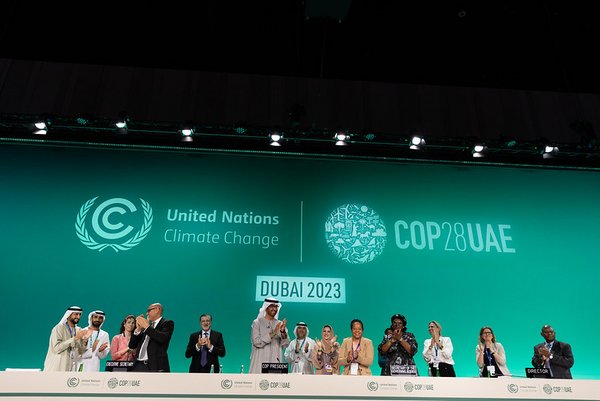 Read this article in French
Read this article in French- Share this article
- Subscribe to our newsletter
COP28 ends with a ray of hope
The United Nations Climate Change Conference (COP28) in Dubai, United Arabic Emirates (UAE) closed on the 13th December 2023 with an agreement that signals the “beginning of the end” of the fossil fuel era by laying the ground for a swift, just and equitable transition, underpinned by deep emissions cuts and scaled-up finance.
“All in all, COP28 sends a strong signal to the world. For the first time, a world climate conference has called on all nations to organise a turnaround away from coal, oil and gas. That’s an important step,” says Christoph Bals, Policy Director of the non-governmental organisation Germanwatch. “However, this step can only be called historic if a massive phase-out of coil, oil and gas is achieved over the next few years.”
The global stocktake is considered the central outcome of COP28 – as it contains every element that was under negotiation and can now be used by countries to develop stronger climate action plans due by 2025.
The stocktake recognises the science that indicates global greenhouse gas emissions need to be cut 43 per cent by 2030, compared to 2019 levels, to limit global warming to 1.5°C. But it notes Parties are off track when it comes to meeting their Paris Agreement goals.
The stocktake calls on Parties to take actions towards achieving, at a global scale, a tripling of renewable energy capacity and doubling energy efficiency improvements by 2030. The list also includes accelerating efforts towards the phase-down of unabated coal power, phasing out inefficient fossil fuel subsidies and other measures that drive the transition away from fossil fuels in energy systems in a just, orderly and equitable manner, with developed countries continuing to take the lead.
In the short-term, Parties are encouraged to come forward with ambitious, economy-wide emission reduction targets, covering all greenhouse gases, sectors and categories and aligned with the 1.5°C limit in their next round of climate action plans (known as nationally determined contributions) by 2025.
The international relief organisation World Vision views the climate conference outcome with mixed feelings. It maintains that while progress has been made in individual areas in comparison to earlier agreements, the crucial breakthrough many participants had been hoping for before the negotiations has not been achieved. The organisation stresses that above all, the conference failed to reach clear results regarding the phasing out of fossil energy sources. In World Vision’s opinion, the final declaration leaves many loopholes.
Initiatives and Agreements of COP28:
- Agreement on the operationalisation of the loss and damage fund and funding arrangements. Commitments totalling more than 700 million US dollars to date.
- Agreement that the UN Office for Disaster Risk Reduction and the UN Office for Project Services will host the secretariat of the Santiago Network for Loss and Damage. This platform will catalyse technical assistance to developing countries that are particularly vulnerable to the adverse effects of climate change.
- Parties agreed on targets for the Global Goal on Adaptation (GGA) and its framework, which identify where the world needs to get to in order to be resilient to the impacts of a changing climate and to assess countries’ efforts. The GGA framework reflects a global consensus on adaptation targets and the need for finance, technology and capacity-building support to achieve them.
- The Green Climate Fund (GCF) received a boost to its second replenishment with six countries pledging new funding at COP28, with total pledges now standing at a record USD 12.8 billion from 31 countries, with further contributions expected.
- Eight donor governments announced new commitments to the Least Developed Countries Fund and Special Climate Change Fund totalling more than USD 174 million to date, while new pledges, amounting to almost USD 188 million so far, were made to the Adaptation Fund at COP28.
- Discussions continued on setting a “new collective quantified goal on climate finance” in 2024, taking into account the needs and priorities of developing countries. The new goal, which will start from a baseline of USD 100 billion per year, will be a building block for the design and subsequent implementation of national climate plans that need to be delivered by 2025.
- Agreement that the mitigation work programme, which was launched at COP27 last year, will continue until 2030, with at least two global dialogues held each year.
- UN Climate Change is developing the transparency reporting and review tools for use by Parties, which were showcased and tested at COP28. The final versions of the reporting tools should be made available to Parties by June 2024.
As highlighted in the global stocktake, the financial pledges made at COP28 are far short of the trillions of dollars eventually needed to support developing countries with clean energy transitions, implementing their national climate plans and adaptation efforts.
In order to deliver such funding, the global stocktake underscores the importance of reforming the multilateral financial architecture, and accelerating the ongoing establishment of new and innovative sources of finance.
COP28 also saw Parties agree to Azerbaijan as host of COP29 from the 11th-22nd November 2024, and Brazil as COP30 host from the 10th-21st November 2025.
The next two years will be critical. At COP29, governments must establish a new climate finance goal, reflecting the scale and urgency of the climate challenge. And at COP30, they must come prepared with new nationally determined contributions that are economy-wide, cover all greenhouse gases and are fully aligned with the 1.5°C temperature limit.
(UNFCCC/Germanwatch/World Vision/ile)
Read more on the UNFCCC website





Add a comment
Be the First to Comment